High-resolution profiling of gammaH2AX around DNA double strand breaks in the mammalian genome
- PMID: 20360682
- PMCID: PMC2868577
- DOI: 10.1038/emboj.2010.38
High-resolution profiling of gammaH2AX around DNA double strand breaks in the mammalian genome
Abstract
Chromatin acts as a key regulator of DNA-related processes such as DNA damage repair. Although ChIP-chip is a powerful technique to provide high-resolution maps of protein-genome interactions, its use to study DNA double strand break (DSB) repair has been hindered by the limitations of the available damage induction methods. We have developed a human cell line that permits induction of multiple DSBs randomly distributed and unambiguously positioned within the genome. Using this system, we have generated the first genome-wide mapping of gammaH2AX around DSBs. We found that all DSBs trigger large gammaH2AX domains, which spread out from the DSB in a bidirectional, discontinuous and not necessarily symmetrical manner. The distribution of gammaH2AX within domains is influenced by gene transcription, as parallel mappings of RNA Polymerase II and strand-specific expression showed that gammaH2AX does not propagate on active genes. In addition, we showed that transcription is accurately maintained within gammaH2AX domains, indicating that mechanisms may exist to protect gene transcription from gammaH2AX spreading and from the chromatin rearrangements induced by DSBs.
Conflict of interest statement
The authors declare that they have no conflict of interest.
Figures
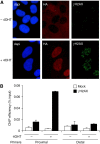
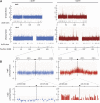

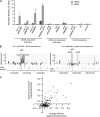

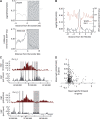

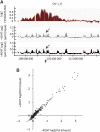
Similar articles
-
Deciphering the chromatin landscape induced around DNA double strand breaks.Cell Cycle. 2010 Aug 1;9(15):2963-72. doi: 10.4161/cc.9.15.12412. Cell Cycle. 2010. PMID: 20714222
-
Cohesin protects genes against γH2AX Induced by DNA double-strand breaks.PLoS Genet. 2012 Jan;8(1):e1002460. doi: 10.1371/journal.pgen.1002460. Epub 2012 Jan 19. PLoS Genet. 2012. PMID: 22275873 Free PMC article.
-
DNA double-strand breaks induce H2Ax phosphorylation domains in a contact-dependent manner.Nat Commun. 2020 Jun 22;11(1):3158. doi: 10.1038/s41467-020-16926-x. Nat Commun. 2020. PMID: 32572033 Free PMC article.
-
Mechanism of elimination of phosphorylated histone H2AX from chromatin after repair of DNA double-strand breaks.Mutat Res. 2010 Mar 1;685(1-2):54-60. doi: 10.1016/j.mrfmmm.2009.08.001. Epub 2009 Aug 12. Mutat Res. 2010. PMID: 19682466 Review.
-
Genome Instability and γH2AX.Int J Mol Sci. 2017 Sep 15;18(9):1979. doi: 10.3390/ijms18091979. Int J Mol Sci. 2017. PMID: 28914798 Free PMC article. Review.
Cited by
-
Structural mechanism of the phosphorylation-dependent dimerization of the MDC1 forkhead-associated domain.Nucleic Acids Res. 2012 May;40(9):3898-912. doi: 10.1093/nar/gkr1296. Epub 2012 Jan 10. Nucleic Acids Res. 2012. PMID: 22234877 Free PMC article.
-
Double strand breaks: hurdles for RNA polymerase II transcription?Transcription. 2013 Jan-Feb;4(1):34-8. doi: 10.4161/trns.22879. Transcription. 2013. PMID: 23340208 Free PMC article. Review.
-
Truncating mutation in the autophagy gene UVRAG confers oncogenic properties and chemosensitivity in colorectal cancers.Nat Commun. 2015 Aug 3;6:7839. doi: 10.1038/ncomms8839. Nat Commun. 2015. PMID: 26234763 Free PMC article.
-
The mortal strand hypothesis: non-random chromosome inheritance and the biased segregation of damaged DNA.Semin Cell Dev Biol. 2013 Aug-Sep;24(8-9):653-60. doi: 10.1016/j.semcdb.2013.05.006. Epub 2013 May 21. Semin Cell Dev Biol. 2013. PMID: 23701893 Free PMC article. Review.
-
Chaperoning histones at the DNA repair dance.DNA Repair (Amst). 2021 Dec;108:103240. doi: 10.1016/j.dnarep.2021.103240. Epub 2021 Oct 13. DNA Repair (Amst). 2021. PMID: 34687987 Free PMC article. Review.
References
-
- Agger K, Santoni-Rugiu E, Holmberg C, Karlstrom O, Helin K (2005) Conditional E2F1 activation in transgenic mice causes testicular atrophy and dysplasia mimicking human CIS. Oncogene 24: 780–789 - PubMed
-
- Barski A, Cuddapah S, Cui K, Roh TY, Schones DE, Wang Z, Wei G, Chepelev I, Zhao K (2007) High-resolution profiling of histone methylations in the human genome. Cell 129: 823–837 - PubMed
-
- Berkovich E, Monnat RJ Jr, Kastan MB (2007) Roles of ATM and NBS1 in chromatin structure modulation and DNA double-strand break repair. Nat Cell Biol 9: 683–690 - PubMed
-
- Celeste A, Fernandez-Capetillo O, Kruhlak MJ, Pilch DR, Staudt DW, Lee A, Bonner RF, Bonner WM, Nussenzweig A (2003) Histone H2AX phosphorylation is dispensable for the initial recognition of DNA breaks. Nat Cell Biol 5: 675–679 - PubMed
Publication types
MeSH terms
Substances
Grants and funding
LinkOut - more resources
Full Text Sources
Other Literature Sources

